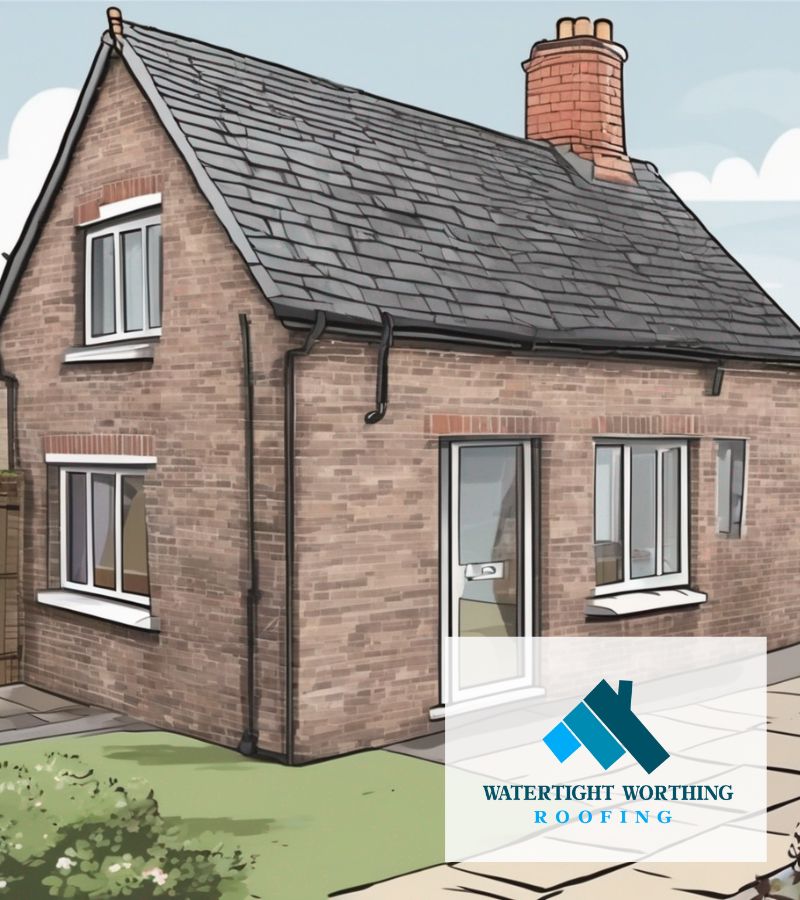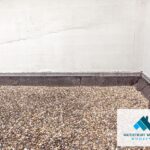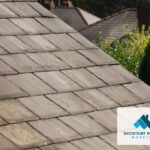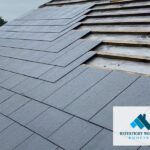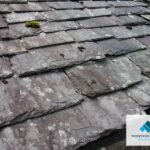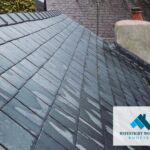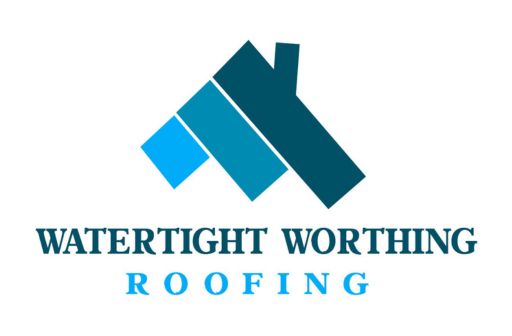Tired of the same old flat roofs? Want to bring charm and versatility to your home or building design? Look no further than pitched roofing! This sloped design has been a staple in the UK for centuries, evolving with changing architectural trends.
What makes pitched roofing so special? Why should you consider it for your next project? Let’s find out.
Pitched roofing offers many advantages, from attractive appearances to improved drainage and insulation. You can also customize your space with the wide range of roof designs, like gable, hip, or mansard styles.
Don’t worry about maintenance either – we can help you with that. Join us and unlock the charm and versatility of sloped designs with pitched roofing in the UK.
History and Evolution of Pitched Roofing in the UK
You can imagine yourself walking through the streets of old English villages, with their charming thatched roofs and timber-framed houses, pondering the rich history and evolution of pitched roofing in the UK.
Dating back centuries, pitched roofs have been influenced by Gothic, Tudor, Georgian, and Victorian architectural styles, each bringing its own features and design elements. These designs served practical purposes, such as weather protection, and became expressions of cultural identity.
Modern materials and technologies offer new possibilities for roofing design, yet many homeowners still prefer the traditional charm and versatility of sloped roofs. Whether it’s a thatched cottage or a timber-framed house, pitched roofing continues to captivate us with its timeless appeal.
Benefits of Pitched Roofing
Imagine the sense of security and protection that comes with a pitched roof, like a guardian angel watching over your home. Pitched roofing offers numerous advantages, making it an ideal choice for UK homeowners.
Its steep slope enables rainwater to quickly flow off, avoiding any possible leaks or water damage, ensuring your home remains dry and secure even during intense rainfall.
Additionally, the design of a pitched roof offers extra attic space, allowing for storage or potential living areas. The beauty of a sloped roof is undeniable, adding appeal and character to a property.
However, it’s essential to consider some disadvantages too. Pitched roofs can be pricier to install compared to flat roofs due to the extra materials and labor necessary. Maintenance and repairs may also require a roofing company for assistance due to the complexity of the design.
Despite these drawbacks, the benefits of pitched roofing in terms of protection, aesthetics, and additional space make it a popular choice among homeowners who want assurance and variety.
Types of Pitched Roof Designs
Experience the elegance and functionality of various types of pitched roof designs, each offering its own style and advantages to enhance your home. Here are three types of pitched roof designs that will elevate the aesthetic appeal of your house and provide practical benefits:
- Gable Roof: This classic design features two sloping sides forming a triangular shape, creating a timeless charm while maximizing attic space for storage or additional living areas.
- Hip Roof: With slopes on all four sides, this design offers stability, ideal for regions prone to high winds or heavy snowfall. Its structure allows for easy installation of dormers or skylights.
- Mansard Roof: Known for its French-inspired elegance, this design combines steep lower slopes with flatter upper slopes to create extra living space in the attic. It provides an opportunity for expansion without compromising architectural integrity.
Sloped roofs offer improved drainage, enhanced energy efficiency, and increased durability against harsh weather conditions. Upgrade your home with these stylish options today!
Maintenance and Care for Pitched Roofs
To guarantee the strength and usefulness of your pitched roof, it’s vital to do frequent assessments and cleanings.
By identifying any conceivable issues early, you can prevent more harm and costly fixes later on. On the off chance that you spot damaged shingles or tiles during your review, make sure to rapidly fix or supplant them to keep up the soundness of your roof’s structure.
Additionally, taking preventive activities, like fixing holes and properly managing gutters, can help stop leaks and water damage from weakening the total condition of your pitched roof.
Regular Inspections and Cleaning
Regular inspections and cleaning are crucial for the long-term health and beauty of your sloped roof. To keep it in top shape, prioritize these four tasks:
- Maintenance: Set up regular check-ups with an experienced roofer to catch any potential issues early. Doing so will help avoid expensive repairs in the future.
- Gutter cleaning: Blocked gutters can cause water to pool and damage your roof’s structure. Keeping them clear of debris will help water flow freely and keep your roof dry.
- Remove debris: Leaves, branches, and other debris can accumulate on your sloped roof over time. Taking it off prevents moisture buildup and rot or mold growth.
- Check for damage: Look out for any signs of wear or damage, like cracked tiles or loose shingles. Acting fast on these will stop further wear and tear and extend your roof’s lifespan.
By following these maintenance practices, your sloped roof will stay functioning and looking great for years to come.
Repairing Damaged Shingles or Tiles
Repairing damaged shingles or tiles is essential to prevent further deterioration and extend the lifespan of your roof. To start, use a pry bar to lift the edge of the shingle, then slide it out from under the overlapping shingle above.
Replace any missing or broken nails with new ones before installing the new shingle.
For replacing tiles, begin by removing any broken or cracked tiles using a hammer and chisel. Carefully lift each tile and slide in a replacement tile to make sure it fits securely in place.
Seal around the edges and secure the tiles in position using roofing cement.
Regular inspections and prompt repairs will help maintain the integrity of your pitched roof for years to come.
Preventing Leaks and Water Damage
Preventing leaks and water damage is vital for keeping the life of your roof, and it’s frightening to realize that a single leak can result in thousands of dollars in repair costs. To make sure your roof remains waterproof, here are some essential waterproofing practices:
- Install high-quality underlayment: A dependable underlayment serves as an additional shield against moisture infiltration.
- Seal all flashing points: Flashing, such as chimney or vent openings, should be appropriately sealed with tough materials to stop water infiltration.
- Maintain gutters and downspouts: Frequently clean and examine your gutters to avoid clogs that can bring about water overflow onto your roof.
- Conduct routine inspections: Regularly look for cracked or missing shingles or tiles and quickly attend to any concerns to prevent further harm.
By executing these preventive steps, you can secure your pitched roof from leaks and possible water damage, ensuring its beauty and versatility stay intact for years to come.
Choosing the Right Materials for Pitched Roofing
When selecting materials for your pitched roof, you should look at traditional options such as slate and clay, which offer a classic look and longevity.
You could also consider modern alternatives like metal and synthetic materials which provide a range of options and a modern style.
Cost and sustainability must also be taken into consideration when deciding, to make sure your choice fits your budget and ecological aims.
Traditional Materials (e.g., Slate, Clay)
Discover the timeless elegance and durability of slate and clay, which bring a touch of sophistication to your pitched roofing design. Traditional craftsmanship emanates with these materials, adding an element of artistry to your roof.
Slate boasts natural beauty and longevity, offering a range of colors and textures that can complement any architectural aesthetic. It resists fire, water, and extreme weather conditions, making it a dependable choice for long-lasting protection.
Clay tiles exude charm with their warm earthy tones and distinctive shapes. They are visually appealing and energy-efficient due to their thermal properties.
By choosing slate or clay as your roofing material, you can create a traditional look while ensuring the durability and strength needed for years of peace of mind about your roof’s performance.
- Sub-list 1:
- Showcase traditional craftsmanship
- Enhance architectural aesthetics
- Sub-list 2:
- Slate: natural beauty, variety of colors/textures
- Clay: warm earthy tones, distinctive shapes
Modern Alternatives (e.g., Metal, Synthetic)
Immersing in the world of metal and synthetic roofing materials, you can experience a combination of innovation and style that creates a roof that’s as visually attractive as it’s functional. Alternatives of metal provide a modern twist to traditional pitched roofs, delivering sturdiness and longevity.
With their clean lines and slick finishes, they bring a touch of refinement to any architectural design. Synthetic roofing materials, on the contrary, let you explore varied colors, textures, and patterns without sacrificing performance. These sophisticated materials are lightweight but solid, making installation simpler and more economical.
Moreover, they have superior resistance to harsh weather conditions like wind, rain, hail, and UV rays. Rejoice in the liberation that comes with selecting modern alternatives for your pitched roof – a union of cutting-edge technology and everlasting beauty.
Considerations for Cost and Sustainability
To truly appreciate the benefits of modern alternatives for your roof, you’ll want to consider cost and sustainability factors.
Metal and synthetic roofing options often offer the most cost-effective solution. Metal roofs are durable, long-lasting, and require minimal maintenance, making them a wise investment in the long run. Synthetic roofs, such as rubber or plastic tiles, offer similar benefits at a lower cost compared to traditional materials such as slate or wood.
When it comes to eco-friendliness, these options are gaining popularity with homeowners who desire liberation from harmful environmental impacts. Metal roofs are recyclable and can even be made from recycled materials. Synthetic roofs reduce the need for cutting down trees or mining natural resources.
In addition, both metal and synthetic roofs have high energy efficiency ratings, which can result in lower utility bills over time.
As you explore modern alternatives for your pitched roof design in the UK, it is important to consider both cost-effectiveness and eco-friendliness.
Frequently Asked Questions
How long does a pitched roof typically last in the UK?
A pitched roof can last around 20 to 30 years in the UK with adequate maintenance. It’s essential to carry out regular inspections and repairs to guarantee its endurance.
UK homes enjoy a variety of advantages from pitched roofs. They offer more efficient insulation, increased energy efficiency, and better protection against extreme weather conditions. Additionally, they provide a classic and attractive look that adds a unique charm and character to any home. They also offer a wide range of design possibilities.
Enjoy the security of a well-maintained pitched roof for many years of reliable protection.
Are there any specific regulations or building codes that need to be followed when installing a pitched roof in the UK?
When installing a pitched roof in the UK, it’s essential to follow certain regulations and building codes. These regulations guarantee the security and durability of your roof.
Installation requirements include appropriate structural support, strong roofing materials, and waterproofing techniques. Furthermore, customization options are plentiful, allowing you to incorporate solar panels for eco-friendly advantages.
Checking regularly for signs of damage and executing necessary maintenance will help expand your roof’s lifespan while providing the freedom you desire.
Can a pitched roof design be customized to match different architectural styles?
You can customize a pitched roof design to fit various architectural styles, giving you a wealth of customization possibilities. This allows you to achieve the desired look and blend seamlessly with the building’s overall design.
The advantages of pitched roofs extend beyond their flexibility, providing enhanced strength, improved drainage, and more attic space. With these benefits and the ability to personalize your roof design, you can fully realize your architectural vision.
Are there any limitations or challenges when it comes to adding solar panels or other eco-friendly features to a pitched roof?
When it comes to adding solar panels or other eco-friendly features to a pitched roof, there are certain restrictions and difficulties to contemplate.
Solar panel suitability is an essential factor, as the angle and orientation of the roof can impact their efficacy. Moreover, the weight of the panels may demand extra structural support.
However, there are a variety of eco-friendly roofing solutions available that can be incorporated seamlessly with a pitched roof design, letting you embrace sustainability while preserving the appeal and versatility of this architectural style.
What are some common signs of damage or wear that homeowners should look out for in their pitched roofs, and how can these issues be addressed?
It’s essential to keep an eye out for signs of damage or wear on your pitched roof to protect its integrity. Cracked or missing shingles, leaks, sagging spots, and decaying wood are all indications that your roof needs attention. Prompt roof repair is necessary to address these issues.
Scheduling regular inspections and performing preventative maintenance will help extend the life of your pitched roof. Taking care of problems quickly can keep them from becoming bigger issues and ensure your roof lasts for years.
We want to take the time to thank you for reading our article, please consider checking out our roofing services below:

